Effect of Upstream Bioactivation of Plant Residues to Accelerate the Composting Process and Improve Product Quality
Abstract
1. Introduction
2. Materials and Methods
2.1. Raw Material
2.2. Microorganisms
2.3. Optimization and Follow-Up of the Bioactivation Assay
2.3.1. Inoculum Preparation
2.3.2. Bioactivation Protocol
2.3.3. Bioactivation Assay: Monitoring Parameters
- Basic control parameters
- Biodegradability indicators
2.4. Real-Scale Composting Process of Bioactivated Material
2.4.1. Pretreatment and Start-Up of Composting Process
2.4.2. Control and Monitoring of the Composting Process
2.5. Statistical Analysis
3. Results and Discussion
3.1. Evaluation of Bioactivation Strategy at the Laboratory Scale
3.1.1. Basic Control Parameters
3.1.2. Respirometric Analysis
3.1.3. Lignocellulosic Fractions and Biodegradation Rates
3.2. Real-Scale Composting Process of Bioactivated Material
4. Conclusions
Author Contributions
Funding
Data Availability Statement
Conflicts of Interest
References
- World Population Prospects, 2017 Revision. Available online: https://population.un.org/wpp/publications/files/wpp2017_keyfindings.pdf (accessed on 20 February 2023).
- FAO. Food and Agriculture Organization: The State of Food Security and Nutrition in the World 2017. Building Resilience for Peace and Food Security. 2017. Available online: https://www.refworld.org.es/docid/5b0860214.html (accessed on 20 February 2023).
- Aznar-Sánchez, J.A.; Velasco-Muñoz, J.F.; García-Arca, D.; López-Felices, B. Identification of opportunities for applying the circular economy to intensive agriculture in Almería (South-East Spain). Agronomy 2020, 10, 1499. [Google Scholar] [CrossRef]
- Pazienza, P.; De Lucia, C. For a new plastics economy in agriculture: Policy reflections on the EU strategy from a local perspective. J. Cleaner Prod. 2020, 253, 119844. [Google Scholar] [CrossRef]
- Duque-Acevedo, M.; Belmonte-Ureña, L.J.; Plaza-Úbeda, J.A.; Camacho-Ferre, F. The management of agricultural waste biomass in the framework of circular economy and bioeconomy: An opportunity for greenhouse agriculture in Southeast Spain. Agronomy 2020, 10, 489. [Google Scholar] [CrossRef]
- Millati, R.; Cahyono, R.B.; Ariyanto, T.; Azzahrani, I.N.; Putri, R.U.; Taherzadeh, M.J. Agricultural, industrial, municipal, and forest wastes. In Sustainable Resource Recovery and Zero Waste Approaches; Taherzadeh, M.J., Bolton, K., Wong, J., Pandey, A., Eds.; Elsevier: Amsterdam, The Netherlands, 2019; pp. 1–22. ISBN 978-04-4464-200-4. [Google Scholar]
- INE National Statistics Institute (Spain). Survey on Waste Generation in the Industrial Sector. 2022. Available online: https://www.ine.es/jaxi/Datos.htm?path=/t26/e068/p02/serie/l0/&file=03001.px (accessed on 15 March 2023).
- De Mendonça Costa, L.A.; de Mendonça Costa, M.S.S.; Damaceno, F.M.; Chiarelotto, M.; Bofinger, J.; Gazzola, W. Bioaugmentation as a strategy to improve the compost quality in the composting process of agro-industrial wastes. Environ. Technol. Innov. 2021, 22, 101478. [Google Scholar] [CrossRef]
- Wu, H.; Ge, Y. Excessive application of fertilizer, agricultural non-point source pollution, and farmers’ policy choice. Sustainability 2019, 11, 1165. [Google Scholar] [CrossRef]
- Greff, B.; Szigeti, J.; Nagy, Á.; Lakatos, E.; Varga, L. Influence of microbial inoculants on co-composting of lignocellulosic crop residues with farm animal manure: A review. J. Environ. Manag. 2022, 302, 114088. [Google Scholar] [CrossRef]
- Jurado, M.; López, M.J.; Suárez-Estrella, F.; Vargas-García, M.C.; López-González, J.A.; Moreno, J. Exploiting composting biodiversity: Study of the persistent and biotechnologically relevant microorganisms from lignocellulose-based composting. Bioresour. Technol. 2014, 162, 283–293. [Google Scholar] [CrossRef] [PubMed]
- Folino, A.; Pangallo, D.; Calabrò, P. Assessing bioplastics biodegradability by standard and research methods: Current trends and open issues. J. Environ. Chem. Eng. 2023, 11, 109424. [Google Scholar] [CrossRef]
- Cucina, M.; De Nisi, P.; Trombino, L.; Tambone, F.; Adani, F. Degradation of bioplastics in organic waste by mesophilic anaerobic digestion, composting and soil incubation. Waste Manag. 2021, 134, 67–77. [Google Scholar] [CrossRef]
- Gadaleta, G.; De Gisi, S.; Todaro, F.; Notarnicola, M. Carbon footprint and total cost evaluation of different bio-plastics waste treatment strategies. Clean Technol. 2022, 4, 570–583. [Google Scholar] [CrossRef]
- Gadaleta, G.; Ferrara, C.; De Gisi, S.; Notarnicola, M.; De Feo, G. Life cycle assessment of end-of-life options for cellulose-based bioplastics when introduced into a municipal solid waste management system. Sci. Total Environ. 2023, 871, 161958. [Google Scholar] [CrossRef]
- ASTM D7075-04; Standard Practice for Evaluating and Reporting Environmental Performance of Biobased Products. ASTM International: West Conshohocken, PA, USA, 2004.
- ISO 14001:2015; Environmental management systems—Requirements with guidance for use. ISO: Geneva, Switzerland, 2015.
- Emadian, S.M.; Onay, T.T.; Demirel, B. Biodegradation of bioplastics in natural environments. Waste Manag. 2017, 59, 526–536. [Google Scholar] [CrossRef]
- Bishop, G.; Styles, D.; Lens, P.N. Environmental performance comparison of bioplastics and petrochemical plastics: A review of life cycle assessment (LCA) methodological decisions. Resour. Conserv. Recycl. 2021, 168, 105451. [Google Scholar] [CrossRef]
- Burgos, N.; Valdés, A.; Jiménez, A. Valorization of agricultural wastes for the production of protein-based biopolymers. J. Renew. Mater. 2016, 4, 165–177. [Google Scholar] [CrossRef]
- Kaur, H.; Banipal, T.S.; Thakur, S.; Bakshi, M.S.; Kaur, G.; Singh, N. Novel biodegradable films with extraordinary tensile strength and flexibility provided by nanoparticles. ACS Sustain. Chem. Eng. 2013, 1, 127–136. [Google Scholar] [CrossRef]
- Zhang, Z.; Yang, H.; Wang, B.; Chen, C.; Zou, X.; Cheng, T.; Li, J. Aerobic co-composting of mature compost with cattle manure: Organic matter conversion and microbial community characterization. Bioresour. Technol. 2023, 382, 129187. [Google Scholar] [CrossRef]
- Liu, N.; Zhou, J.; Han, L.; Huang, G. Characterization of lignocellulosic compositions’ degradation during chicken manure composting with added biochar by phospholipid fatty acid (PLFA) and correlation analysis. Sci. Total Environ. 2017, 586, 1003–1011. [Google Scholar] [CrossRef]
- López-González, J.A.; Suárez-Estrella, F.; Vargas-García, M.C.; López, M.J.; Jurado, M.M.; Moreno, J. Dynamics of bacterial microbiota during lignocellulosic waste composting: Studies upon its structure, functionality and biodiversity. Bioresour. Technol. 2015, 175, 406–416. [Google Scholar] [CrossRef]
- Abdel-Rahman, M.A.; El-Din, M.N.; Refaat, B.M.; Abdel-Shakour, E.H.; Ewais, E.E.D.; Alrefaey, H.M. Biotechnological application of thermotolerant cellulose-decomposing bacteria in composting of rice straw. Ann. Agric. Sci. 2016, 61, 135–143. [Google Scholar] [CrossRef]
- Duan, M.; Zhang, Y.; Zhou, B.; Qin, Z.; Wu, J.; Wang, Q.; Yin, Y. Effects of Bacillus subtilis on carbon components and microbial functional metabolism during cow manure–straw composting. Bioresour. Technol. 2020, 303, 122868. [Google Scholar] [CrossRef]
- Martínez-Gallardo, M.R.; López, M.J.; Jurado, M.M.; Suárez-Estrella, F.; López-González, J.A.; Sáez, J.A.; Moral, R.; Moreno, J. Bioremediation of Olive Mill Wastewater sediments in evaporation ponds through in situ composting assisted by bioaugmentation. Sci. Total Environ. 2020, 703, 135537. [Google Scholar] [CrossRef]
- López-González, J.A.; Vargas-García, M.C.; López, M.J.; Suárez-Estrella, F.; Jurado, M.; Moreno, J. Enzymatic characterization of microbial isolates from lignocellulose waste composting: Chronological evolution. J. Environ. Manag. 2014, 145, 137–146. [Google Scholar] [CrossRef] [PubMed]
- Satomi, M.; La Duc, M.T.; Venkateswaran, K. Bacillus safensis sp. nov., isolated from spacecraft and assembly-facility surfaces. Int. J. Syst. Evol. Microbiol. 2006, 56, 1735–1740. [Google Scholar] [CrossRef]
- Kothari, V.V.; Kothari, R.K.; Kothari, C.R.; Bhatt, V.D.; Nathani, N.M.; Koringa, P.G.; Joshi, C.G.; Vyas, B.R. Genome Sequence of Salt-Tolerant Bacillus safensis Strain VK, Isolated from Saline Desert Area of Gujarat, India. Genome Announc. 2013, 1, e00671-13. [Google Scholar] [CrossRef] [PubMed]
- Miles, A.A.; Misra, S.S.; Irwin, J.O. The estimation of the bactericidal power of the blood. Epidemiol. Infect. 1938, 38, 732–749. [Google Scholar] [CrossRef]
- Barrena, R.; Pagans, E.; Faltys, G.; Sánchez, A. Effect of inoculation dosing on the composting of source-selected organic fraction of municipal solid wastes. J. Chem. Technol. Biotechnol. 2006, 81, 420–425. [Google Scholar] [CrossRef]
- Jurado, M.M.; Suárez-Estrella, F.; López, M.J.; Vargas-García, M.C.; López-González, J.A.; Moreno, J. Enhanced turnover of organic matter fractions by microbial stimulation during lignocellulosic waste composting. Biores. Technol. 2015, 186, 15–24. [Google Scholar] [CrossRef] [PubMed]
- Wang, H.; Fan, B.; Hu, Q.; Yin, Z. Effect of inoculation with Penicillium expansum on the microbial community and maturity of compost. Biores. Technol. 2011, 102, 11189–11193. [Google Scholar] [CrossRef]
- Barrena, R.; d’Imporzano, G.; Ponsá, S.; Gea, T.; Artola, A.; Vázquez, F.; Sánchez, A.; Adani, F. In search of a reliable technique for the determination of the biological stability of the organic matter in the mechanical–biological treated waste. J. Hazar. Mater. 2009, 162, 1065–1072. [Google Scholar] [CrossRef]
- Ponsá, S.; Gea, T.; Sánchez, A. Different indices to express biodegradability in organic solid wastes. J. Environ. Qual. 2010, 39, 706–712. [Google Scholar] [CrossRef]
- Adani, F.; Ubbiali, C.; Generini, P. The determination of biological stability of composts using the Dynamic Respiration Index: The results of experience after two years. Waste Manag. 2006, 26, 41–48. [Google Scholar] [CrossRef]
- Antizar-Ladislao, B.; Lopez-Real, J.; Beck, A.J. Degradation of polycyclic aromatic hydrocarbons (PAHs) in an aged coal tar contaminated soil under in-vessel composting conditions. Environ. Pollut. 2006, 141, 459–468. [Google Scholar] [CrossRef]
- Tomati, U.; Madejon, E.; Galli, E. Evolution of humic acid molecular weight as an index of compost stability. Compost Sci. Util. 2000, 8, 108–115. [Google Scholar] [CrossRef]
- Castaldi, P.; Alberti, G.; Merella, R.; Melis, P. Study of the organic matter evolution during municipal solid waste composting aimed at identifying suitable parameters for the evaluation of compost maturity. Waste Manag. 2005, 25, 209–213. [Google Scholar] [CrossRef]
- Liang, C.; Das, K.C.; McClendon, R.W. The influence of temperature and moisture contents regimes on the aerobic microbial activity of a biosolids composting blend. Biores. Technol. 2003, 86, 131–137. [Google Scholar] [CrossRef]
- Moreno, J.; Moral, R. Compostaje; Mundi-Prensa: Madrid, Spain, 2008; 570p. [Google Scholar]
- Azim, K.; Soudi, B.; Boukhari, S.; Perissol, C.; Roussos, S.; Thami Alami, I. Composting parameters and compost quality: A literature review. Org. Agric. 2018, 8, 141–158. [Google Scholar] [CrossRef]
- Iglesias-Jiménez, E.; Barral-Silva, M.T.; Marhuenda-Egea, F. Indicadores de la Estabilidad y Madurez del Compost. In Compostaje; Moreno Casco, J., Moral Herrero, R., Eds.; Mundi Prensa: Madrid, Spain, 2008; pp. 243–283. [Google Scholar]
- Hue, N.V.; Liu, J. Predicting compost stability. Compost Sci. Util. 1995, 3, 8–15. [Google Scholar] [CrossRef]
- Haddadin, M.S.; Haddadin, J.; Arabiyat, O.I.; Hattar, B. Biological conversion of olive pomace into compost by using Trichoderma harzianum and Phanerochaete chrysosporium. Biores. Technol. 2009, 100, 4773–4782. [Google Scholar] [CrossRef]
- Francou, C.; Linères, M.; Derenne, S.; Le Villio-Poitrenaud, M.; Houot, S. Influence of green waste, biowaste and paper-cardboard initial ratios on organic matter transformations during composting. Biores. Technol. 2008, 99, 8926–8934. [Google Scholar] [CrossRef]
- Malherbe, S.; Cloete, T.E. Lignocellulose biodegradation: Fundamentals and applications. Rev. Environ. Sci. Biotechnol. 2002, 1, 105–114. [Google Scholar] [CrossRef]
- Smidt, E.; Meissl, K.; Schmutzer, M.; Hinterstoisser, B. Co-composting of lignin to build up humic substances—Strategies in waste management to improve compost quality. Ind. Crops Prod. 2008, 27, 196–201. [Google Scholar] [CrossRef]
- EPA (Environmental Protection Agency, USA). Environmental Regulations and Technology. Control of Pathogens and Vector Attraction in Sewage Sludge; EPA625-R-92-013; EPA: Washington, DC, USA, 2023.
- Stentiford, E.; de Bertoldi, M. Composting: Process. In Solid Waste Technology & Management; Christensen, T.H., Ed.; John Wiley & Sons Ltd.: Chichester, UK, 2010; Volume 1–2. [Google Scholar]
- BOE-A-2017-14332; Regulation 999/2017 on Fertilizer Products. Ministry of the Presidency and for the Territorial Administrations: Madrid, Spain, 2017; pp. 119396–119450.
- Ameen, A.; Ahmad, J.; Raza, S. Effect of pH and moisture content on composting of Municipal solid waste. Int. J. Sci. Res. Publ. 2016, 6, 35–37. [Google Scholar]
- Komilis, D.P.; Ham, R.K. The effect of lignin and sugars to the aerobic decomposition of solid wastes. Waste Manag. 2003, 23, 419–423. [Google Scholar] [CrossRef] [PubMed]
- Said-Pullicino, D.; Kaiser, K.; Guggenberger, G.; Gigliotti, G. Changes in the chemical composition of water-extractable organic matter during composting: Distribution between stable and labile organic matter pools. Chemosphere 2007, 66, 2166–2176. [Google Scholar] [CrossRef] [PubMed]
- Estrella-González, M.J.; Suárez-Estrella, F.; Jurado, M.M.; López, M.J.; López-González, J.A.; Siles-Castellano, A.B.; Muñoz-Mérida, A.; Moreno, J. Uncovering new indicators to predict stability, maturity and biodiversity of compost on an industrial scale. Bioresour. Technol. 2020, 313, 123557. [Google Scholar] [CrossRef]
- Wei, H.; Tucker, M.P.; Baker, J.P.; Harris, M.; Luo, Y.; Xu, Q.; Himmel, M.E.; Dimg, S.Y. Tracking dynamics of plant biomass composting by changes in substrate structure, microbial community, and enzyme activity. Biotechnol. Biofuels 2012, 5, 20. [Google Scholar] [CrossRef]
- Estrella-González, M.J.; Jurado, M.M.; Suárez-Estrella, F.; López, M.J.; López-González, J.A.; Siles-Castellano, A.; Moreno, J. Enzymatic profiles associated with the evolution of the lignocellulosic fraction during industrial-scale composting of anthropogenic waste: Comparative analysis. J. Environ. Manag. 2019, 248, 109312. [Google Scholar] [CrossRef] [PubMed]
- Wang, L.; Wang, T.; Xing, Z.; Zhang, Q.; Niu, X.; Yu, Y.; Teng, Z.; Chen, J. Enhanced lignocellulose degradation and composts fertility of cattle manure and wheat straw composting by Bacillus inoculation. J. Environ. Chem. Eng. 2023, 11, 109940. [Google Scholar] [CrossRef]
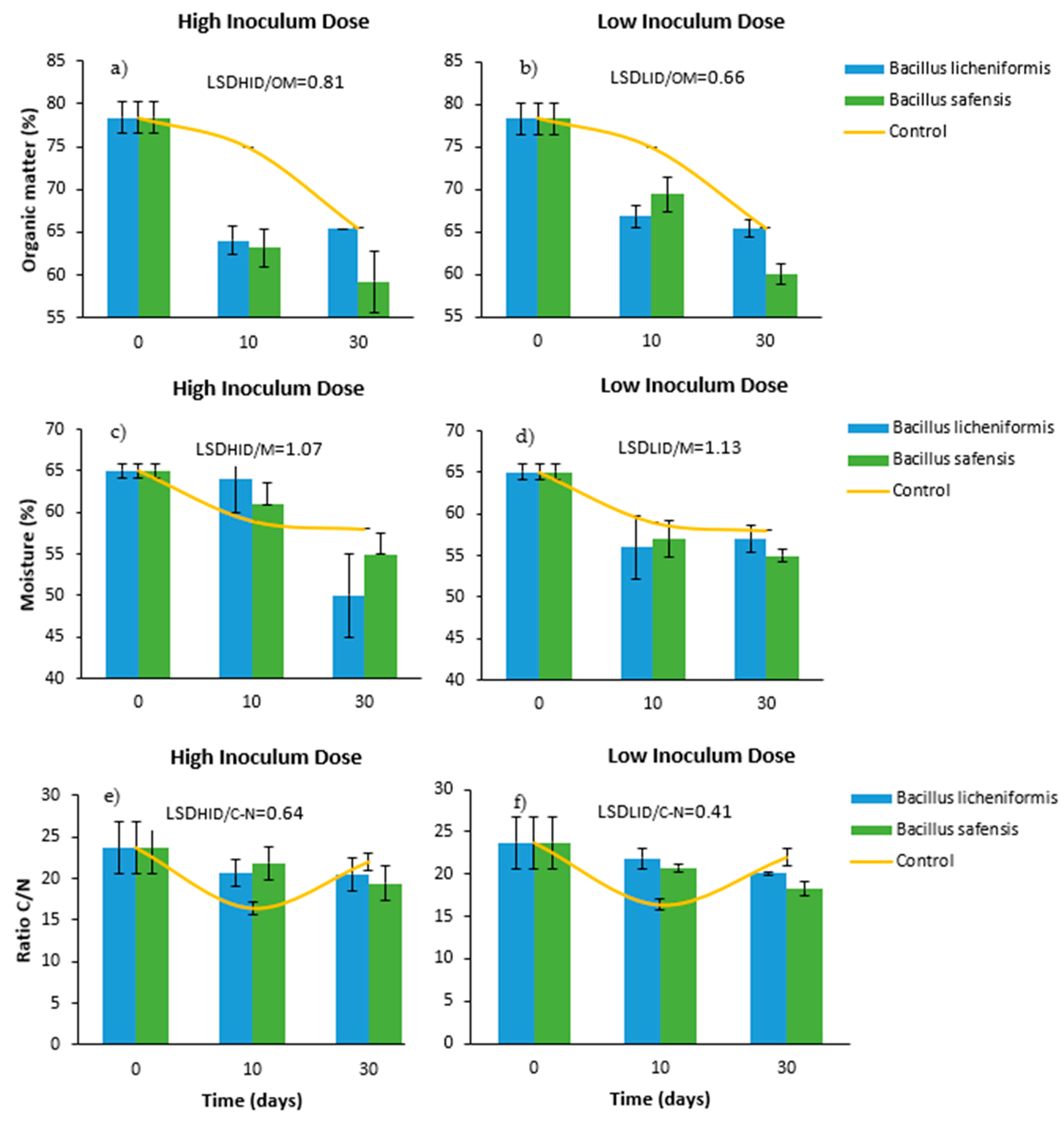

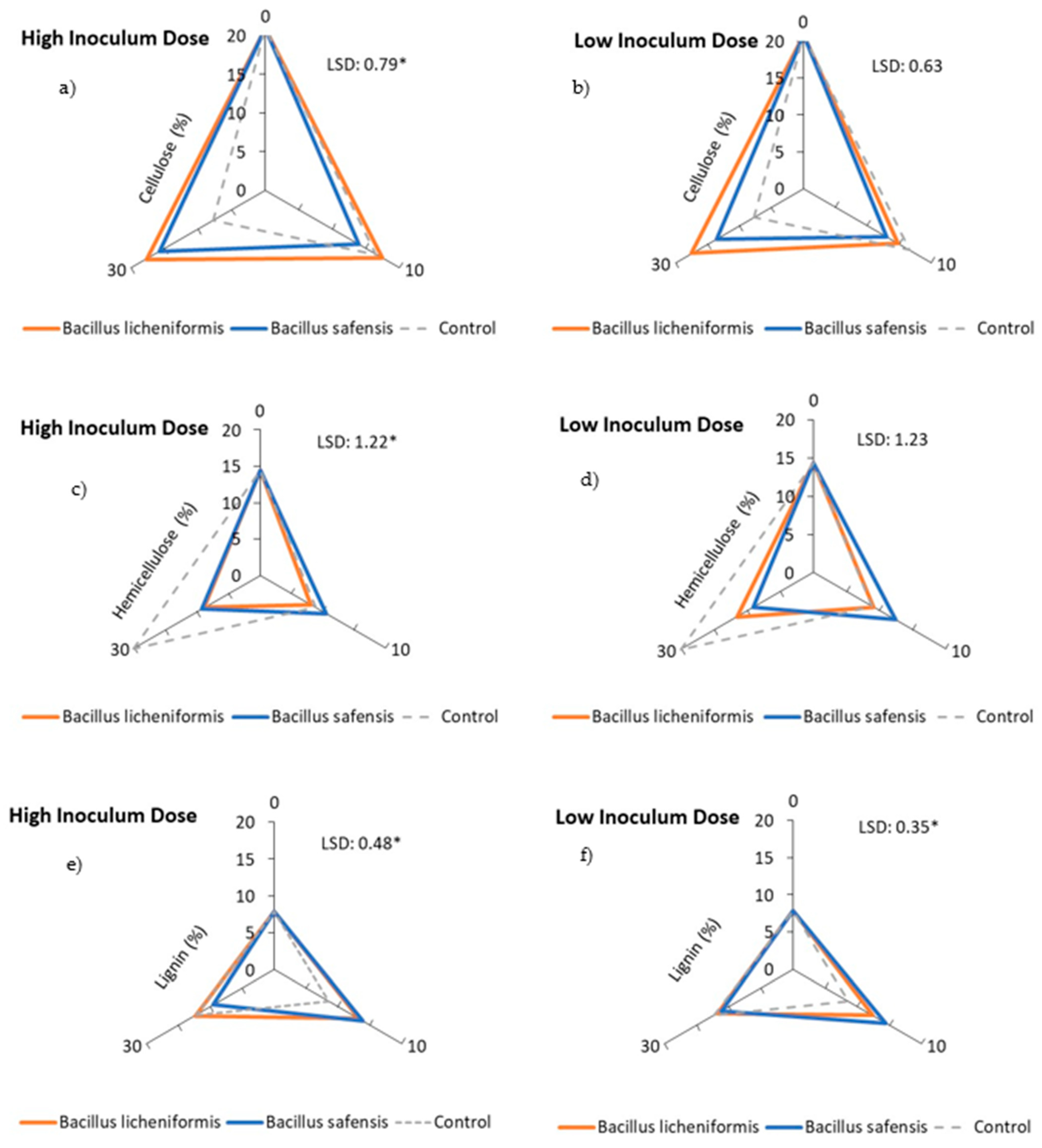
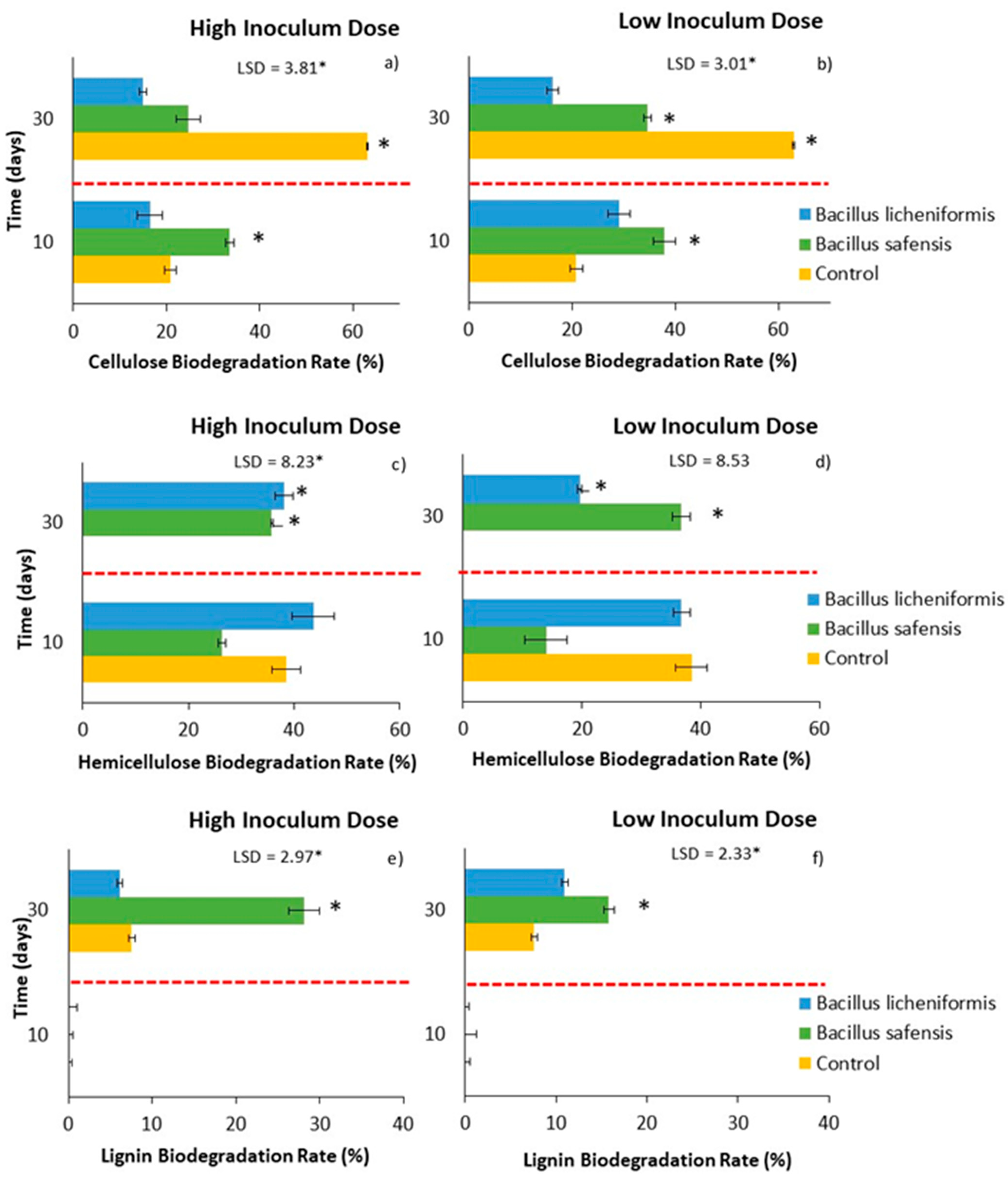
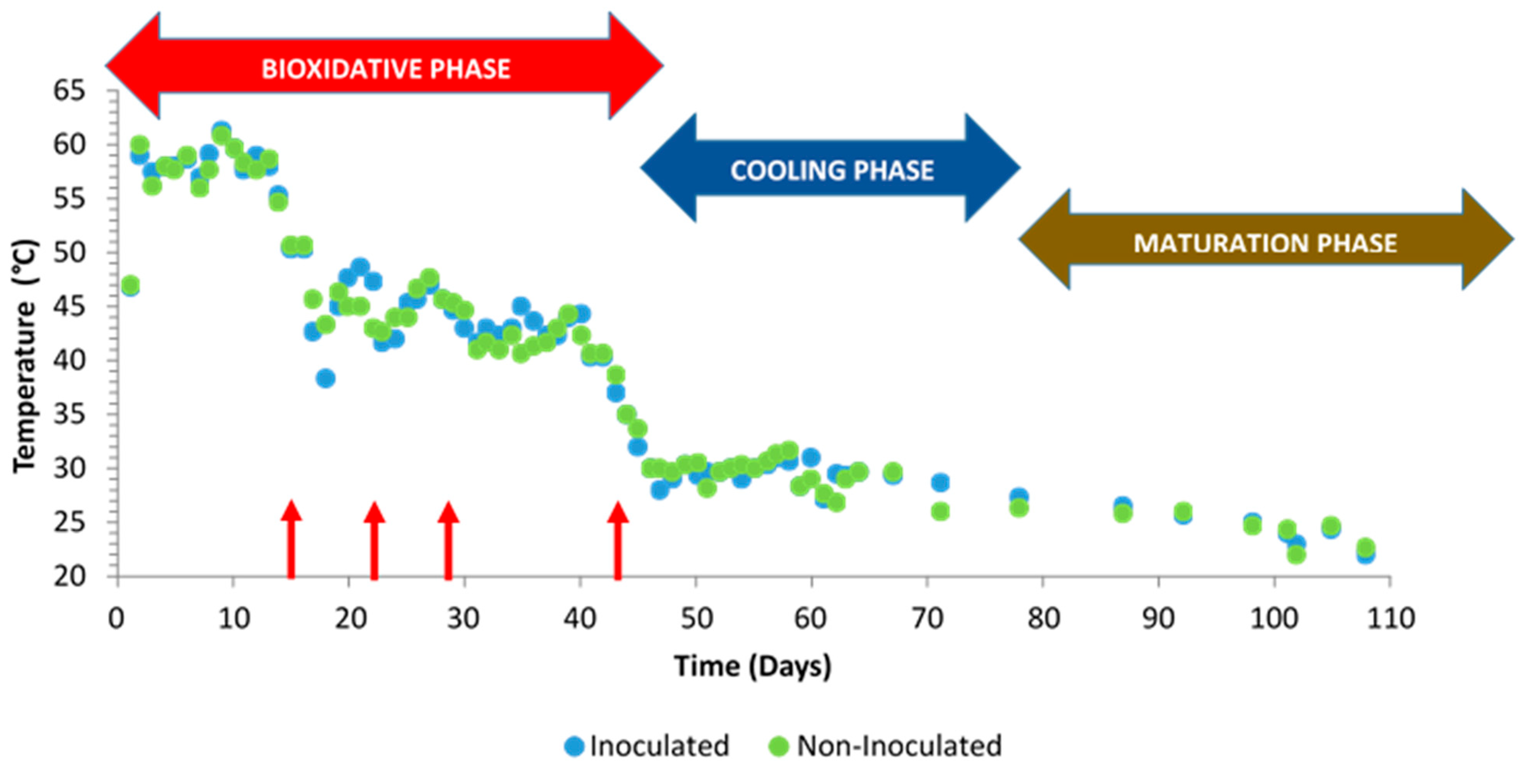
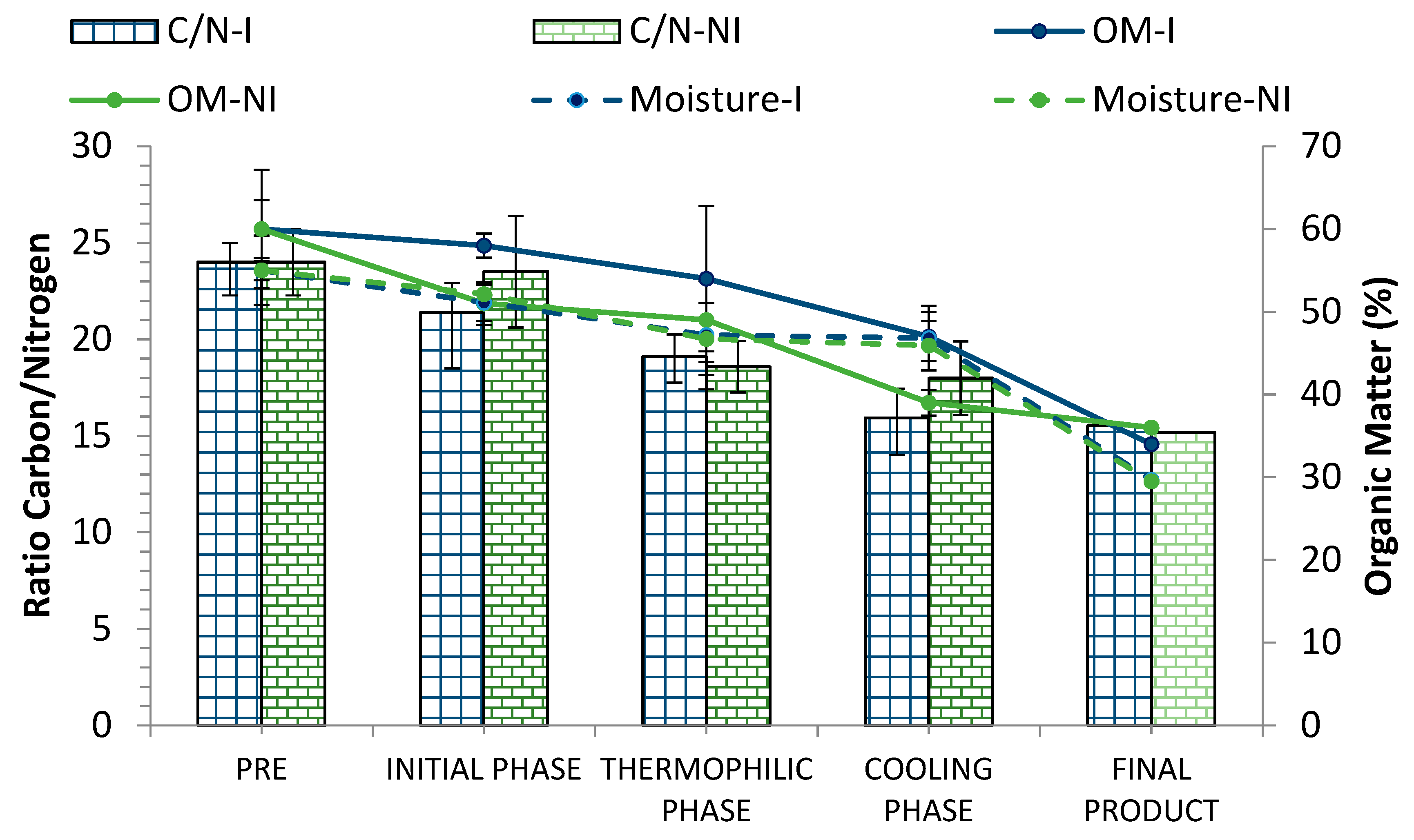
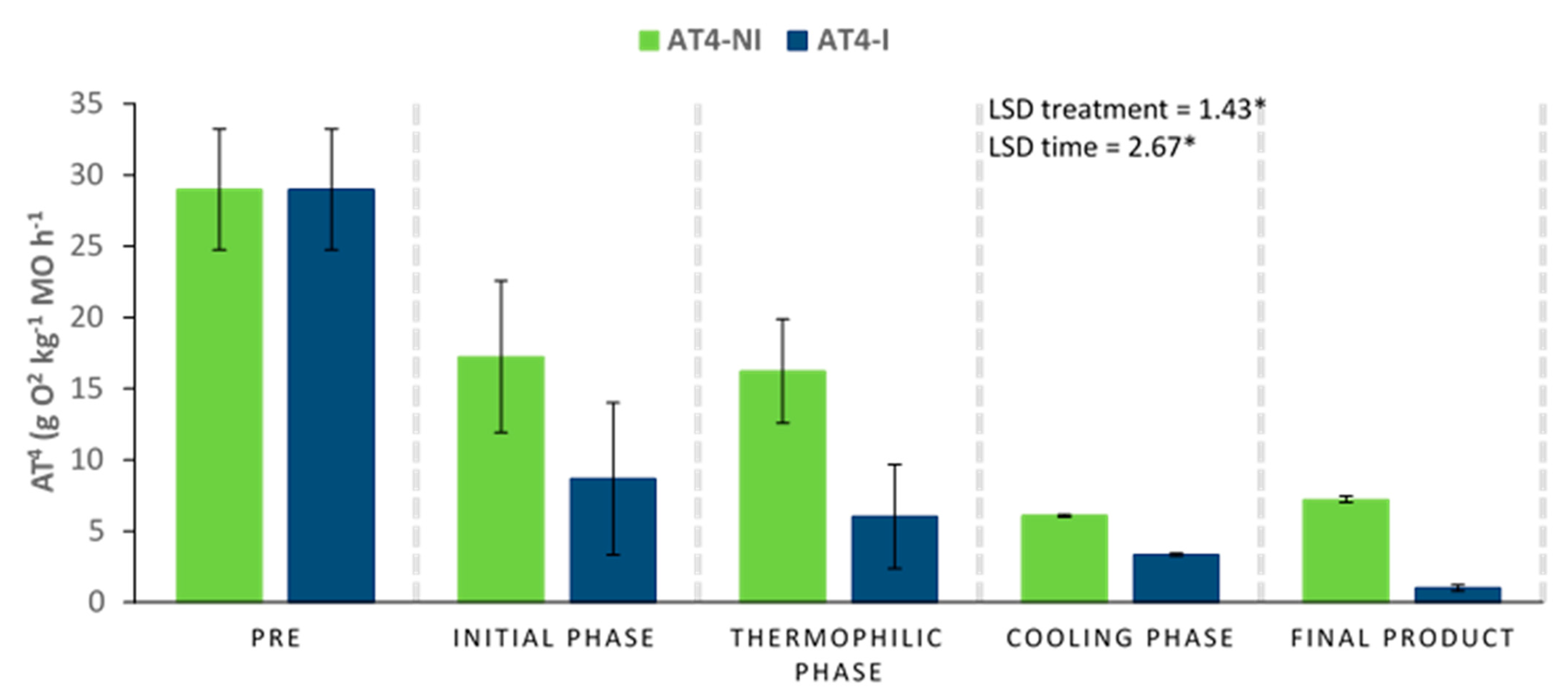

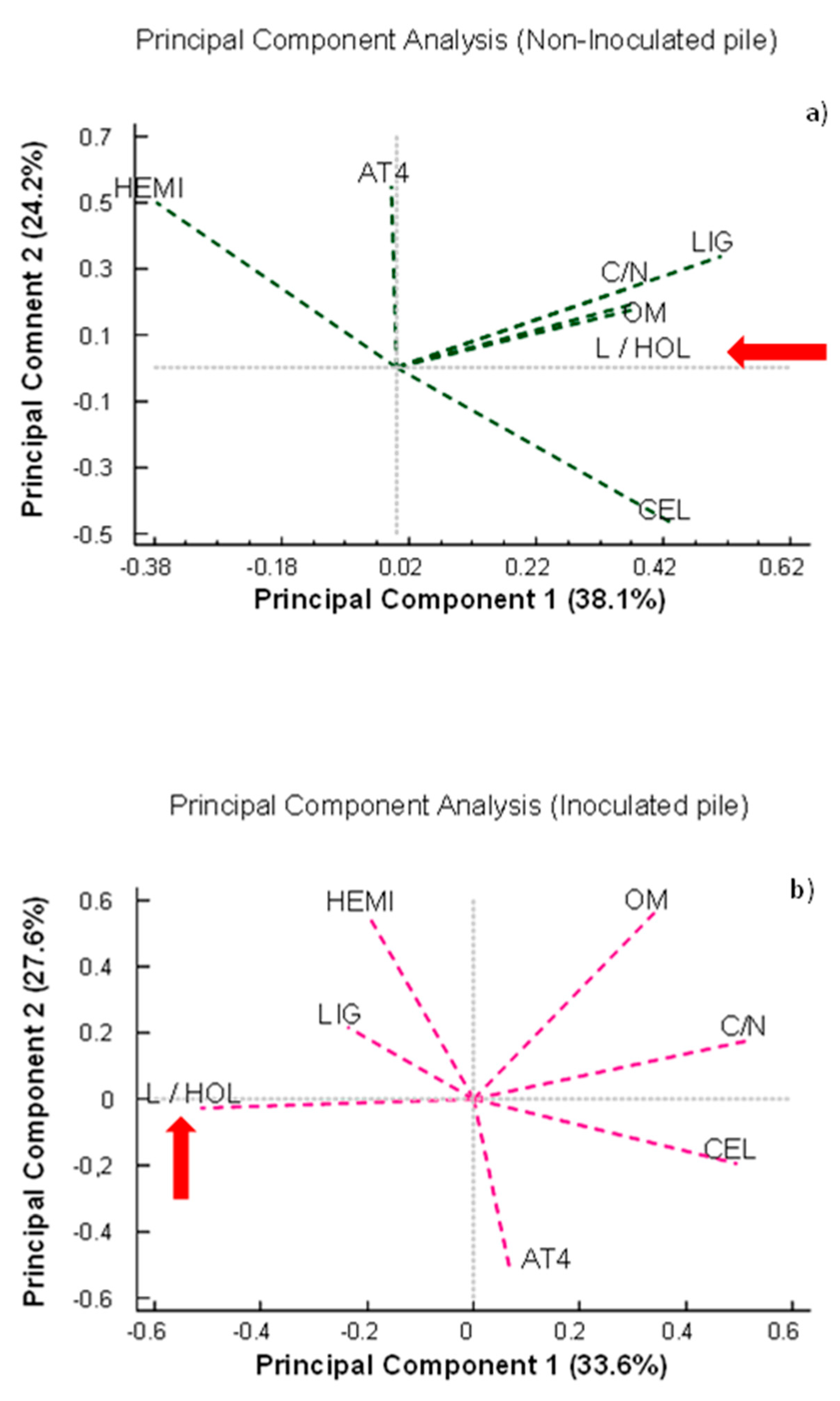
| Material | Moisture (%) | Apparent Density (t m3) | C * (%) | N ** (%) | OM *** (%) |
|---|---|---|---|---|---|
| Plant waste | 63.70 | 0.3 | 35.98 | 1.42 | 80.07 |
| Pruning waste | 7.50 | 0.7 | 29.30 | 0.8 | 29.86 |
Disclaimer/Publisher’s Note: The statements, opinions and data contained in all publications are solely those of the individual author(s) and contributor(s) and not of MDPI and/or the editor(s). MDPI and/or the editor(s) disclaim responsibility for any injury to people or property resulting from any ideas, methods, instructions or products referred to in the content. |
© 2023 by the authors. Licensee MDPI, Basel, Switzerland. This article is an open access article distributed under the terms and conditions of the Creative Commons Attribution (CC BY) license (https://creativecommons.org/licenses/by/4.0/).
Share and Cite
Martínez-Gallardo, M.R.; Estrella-González, M.J.; Suárez-Estrella, F.; López-González, J.A.; Jurado, M.M.; Toribio, A.J.; López, M.J. Effect of Upstream Bioactivation of Plant Residues to Accelerate the Composting Process and Improve Product Quality. Agronomy 2023, 13, 1638. https://doi.org/10.3390/agronomy13061638
Martínez-Gallardo MR, Estrella-González MJ, Suárez-Estrella F, López-González JA, Jurado MM, Toribio AJ, López MJ. Effect of Upstream Bioactivation of Plant Residues to Accelerate the Composting Process and Improve Product Quality. Agronomy. 2023; 13(6):1638. https://doi.org/10.3390/agronomy13061638
Chicago/Turabian StyleMartínez-Gallardo, María R., María J. Estrella-González, Francisca Suárez-Estrella, Juan A. López-González, Macarena M. Jurado, Ana J. Toribio, and María J. López. 2023. "Effect of Upstream Bioactivation of Plant Residues to Accelerate the Composting Process and Improve Product Quality" Agronomy 13, no. 6: 1638. https://doi.org/10.3390/agronomy13061638
APA StyleMartínez-Gallardo, M. R., Estrella-González, M. J., Suárez-Estrella, F., López-González, J. A., Jurado, M. M., Toribio, A. J., & López, M. J. (2023). Effect of Upstream Bioactivation of Plant Residues to Accelerate the Composting Process and Improve Product Quality. Agronomy, 13(6), 1638. https://doi.org/10.3390/agronomy13061638









